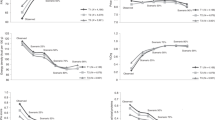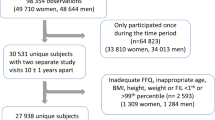Abstract
Background/Objectives:
Results from studies evaluating the sustainability of diets combining environmental and nutritional aspects have been diverse; thus, greenhouse gas emissions (that is, carbon footprint (CF)) of diets in line with dietary recommendations in free-living individuals warrants further examination. Here, changes in dietary CF related to changes in food choice during a weight loss trial among lactating women who received a 12-week diet intervention based on the Nordic Nutrition Recommendations (NNR) 2004 were analyzed. The objective of this study was to examine if a diet intervention based on NNR 2004 results in reduced dietary CF.
Subjects/Methods:
Changes in dietary CF were analyzed among 61 lactating women participating in a weight loss trial. Food intake data from 4-day weighed diet records and results from life cycle analyses were used to examine changes in dietary CF across eight food groups during the intervention, specified in the unit carbon dioxide equivalent (CO2eq/day). Differences in changes in dietary CF between women receiving diet treatment (D-group) and women not receiving it (ND-group) were compared.
Results:
There was no difference in change in dietary CF of the overall diet between D- and ND-group (P>0.05). As for the eight food groups, D-group increased their dietary CF from fruit and vegetables (+0.06±0.13 kg CO2eq/day) compared with a decrease in ND-group (−0.01±0.01 kg CO2eq/day) during the intervention, P=0.01.
Conclusions:
A diet intervention in line with NNR 2004 produced clinically relevant weight loss, but did not reduce dietary CF among lactating women with overweight and obesity. Dietary interventions especially designed to decrease dietary CF and their coherence with dietary recommendations need further exploration.
This is a preview of subscription content, access via your institution
Access options
Subscribe to this journal
Receive 12 print issues and online access
$259.00 per year
only $21.58 per issue
Buy this article
- Purchase on Springer Link
- Instant access to full article PDF
Prices may be subject to local taxes which are calculated during checkout
Similar content being viewed by others
References
Hansen J, Nazarenko L, Ruedy R, Sato M, Willis J, Del Genio A et al. Earth’s energy imbalance: confirmation and implications. Science 2005; 308: 1431–1435.
IPCC. Climate Change 2014: Synthesis Report Contribution of Working Groups I, II and III to the Fifth Assessment Report of the Intergovernmental Panel on Climate Change Core Writing Team Core Writing Team, Pachauri RK, Core Writing Team, Meyer LA (eds). IPCC: Geneva, Switzerland, 2014, p 151.
Smith P, Bustamante M, Ahammad H, Clark H, Dong H, Elsiddig EA et alAgriculture, forestry and other land use (AFOLU). In: Climate Change 2014: Mitigation of Climate Change Contribution of Working Group III to the Fifth Assessment Report of the Intergovernmental Panel on Climate Change Edenhofer O, Pichs-Madruga R, Sokona Y, Farahani E, Kadner S, Seyboth K, Adler A, Baum I, Brunner S, Eickemeier P, Kriemann B, Savolainen J, Schlömer S, von Stechow C, Zwickel T, Minx JC (eds). Cambridge University Press: Cambridge, UK and New York, NY, USA, 2014.
Vermeulen SJ, Campbell BM, Ingram JSI . Climate change and food systems. Annu Rev Environ Resour 2012; 37: 195–222.
Angervall T, Sonesson U, Ziegler F, och Cederberg C . Food and climate. Swedish Inst Food Biotechnol 2008, pp 1–26.
The Swedish food agency Food and environment. Available at: https://www.livsmedelsverket.se/en/food-habits-health-and-environment/food-and-environment/ [cited 2016-11-07].
Friel S, Dangour AD, Garnett T, Lock K, Chalabi Z, Roberts I et al. Public health benefits of strategies to reduce greenhouse-gas emissions: food and agriculture. Lancet 2009; 374: 2016–2025.
Steinfeld HGP, Wassenaar T, Castel V, Rosales M, de Haan C Livestock's long shadowEnviromental Issues and Options. FAO: Rome, 2006.
European Commission Joint Research Centre Environmental Impact of Products (EIPRO). European Commission, Joint Research Centre, Institute for Prospective Technological Studies, 2006.
Bryngelsson D, Wirzenius S, Hedenus F, Sonesson U . How can the EU climate targets be met? A combined analysis of technological and demand-side changes in food and agriculture. Food Policy 2016; 59: 152–164.
Tilman D, Clark M . Global diets link environmental sustainability and human health. Nature 2014; 515: 518–522.
Risku-Norja HKS, Helenius J . Dietary choices and greenhouse gas emissions - assessment of impact of vegetarian and organic options at national scale. Progr Industrial Ecol Int J 2009; 6: 340–354.
Garnett T . Fruit and Vegetables & UK Greenhouse Gas Emissions; Exploring the Relationship. Centre for Environmental Strategy, University of Surrey: Guildford, UK, 2006.
Davis J, Flysjö A . Local Production and Consumption of Legumes in West Sweden. SP Technical Research Institute of Sweden, 2006.
Cederberg C, Hedenus F, Wirenius S, Sonesson U . Trends in greenhouse gas emissions from consumption and production of animal food products – implications for long-term climate targets. Animal 2013; 7: 330–340.
World Cancer Research Fund, American Institute for Cancer Research Food, Nutrition, Physical Activity, and the Prevention of Cancer: A Global Perspective. World Cancer Research Fund, American Institute for Cancer Research AICR: Washington, DC, USA, 2007.
Röös E, Karlsson H, Witthöft C, Sundberg C . Evaluating the sustainability of diets–combining environmental and nutritional aspects. Environ Sci Pol 2015; 47: 157–166.
Drewnowski A, Rehm CD, Martin A, Verger EO, Voinnesson M, Imbert P . Energy and nutrient density of foods in relation to their carbon footprint. Am J Clin Nutr 2015; 101: 184–191.
Bertz F, Brekke HK, Ellegard L, Rasmussen KM, Wennergren M, Winkvist A . Diet and exercise weight-loss trial in lactating overweight and obese women. Am J Clin Nutr 2012; 96: 698–705.
Huseinovic E, Winkvist A, Bertz F, Brekke HK . Changes in food choice during a successful weight loss trial in overweight and obese postpartum women. Obesity 2014; 22: 2517–2523.
Ministers of the Nordic Countries Nordic Nutrition Recommendations 2004. Integrating Nutrition and Physical Activity. Norden: Copenhagen, 2004.
Ello-Martin JA, Roe LS, Ledikwe JH, Beach AM, Rolls BJ . Dietary energy density in the treatment of obesity: a year-long trial comparing 2 weight-loss diets. T Am J Clin Nutr 2007; 85: 1465–1477.
Gryka A, Broom J, Rolland C . Global warming: is weight loss a solution? Int J Obes (Lond) 2012; 36: 474–476.
Heitmann BL, Lissner L, Osler M . Do we eat less fat, or just report so? Int J Obes Relat Metab Disord 2000; 24: 435–442.
Lissner L . Measuring food intake in studies of obesity. Public Health Nutr 2002; 5: 889–892.
The Swedish Institute for Food and Biotechnology Climate data on crisps, soda and candy. Excerpts from the report to the Swedish food agency 2011.
The Swedish Institute for Food and Biotechnology. Climate impact of sugar products - communications support. Excerpts from the report to the Nordic Sugar 2009.
The Swedish Institute for Food and Biotechnology. Climate impact of light and dark chocolate - communication support. Excerpt from report to Chokofa 2009.
Conservancy TC. The Carbon Footprint of Fat Tire Amber Ale. The Climate Conservancy 2008.
Vázquez-Rowe I, Rugani B, Benetto E . Tapping carbon footprint variations in the European wine sector. J Cleaner Product 2013; 43: 146–155.
Lorentzon KNK . LCA Data on Orange Juice. SP Technical Research Institute of Sweden, 2009.
Svanes E, Aronsson AS . Carbon footprint of a Cavendish banana supply chain. Int J Life Cycle Assess 2013; 18: 1450–1464.
Davis J . Greenhouse Gas Emissions from the Production of Horticultural Products. SP Technical Research Institute of Sweden, 2011.
Landquist B, Woodhouse A . Climate Footprint of Roots, Vegetables and Spices. SIK, The Swedish Institute for Food and Biotechnology, 2015.
Röös E, Sundberg C, Hansson P-A . Uncertainties in the carbon footprint of food products: a case study on table potatoes. Int J Life Cycle Assess 2010; 15: 478–488.
The Swedish Institute for Food and Biotechnology. Climate impact of bread - the basis of communication, Excerpts from the report to the Bread Institute 2009.
Xu X, Zhang B, Liu Y, Xue Y, Di B . Carbon footprints of rice production in five typical rice districts in China. Acta Ecologica Sinica 2013; 33: 227–232.
Barilla. Environmental Product Declaration of durum wheat semolina dried pasta 2011.
Flysjö ACC, Strid I . LCA Database for Conventional Feed - The Environmental Impact Associated with the Production. SP Technical Research Institute of Sweden, 2008.
Winther U, Ziegler F, Skontorp Hognes E, Emanuelsson A, Sund V, Ellingsen H Project report: carbon footprint and energy use of Norwegian seafood products. SINTEF Fisheries and Aquaculture: Trondheim, Norway, 2009.
Parker RWR, Vázquez-Rowe I, Tyedmers PH . Fuel performance and carbon footprint of the global purse seine tuna fleet. J Cleaner Prod 2015; 103: 517–524.
Nordstedts. Our cook book. Coop och Nordstedts 2009.
Cederberg CFA, Sonesson U, Sund V, och Davis J . Greenhouse Gas Emission from Swedish Consumtion of Meat, Milk and Eggs 1990 and 2005. SIK, The Swedish Institute for Food and Biotechnology, 2009.
Scan. Our products, everyday food, sausage. Available at: http://scan.se/produkter/vardagsmat/korv/2015[cited2016-11-07].
Nilsson K, Flysjö A, Davis J, Sim S, Unger N, Bell S . Comparative life cycle assessment of margarine and butter consumed in the UK, Germany and France. Int J Life Cycle Assess 2010; 15: 916–926.
The Swedish Institute for Food and Biotechnology. Climate impact of vegetable oils. Excerpt from report to Aarhus Karlshamns July, 2008.
Technical Committee of the International EPD system. Enviromental product declaration Extra Virgin Olive Oil 2011.
Berlin J . Environmental life cycle assessment (LCA) of Swedish semi-hard cheese. Int Dairy J 2002; 12: 939–953.
Acknowledgements
This work was supported by grants from the Swedish Research Council (K2009-70X-21091-01-03), the Swedish Council for Working Life and Social Research (2006-0339), the Swedish Nutrition Foundation and the climate fund at the University of Gothenburg.
Author information
Authors and Affiliations
Corresponding author
Ethics declarations
Competing interests
The authors declare no conflict of interest.
Additional information
Supplementary Information accompanies this paper on European Journal of Clinical Nutrition website
Supplementary information
Rights and permissions
About this article
Cite this article
Huseinovic, E., Ohlin, M., Winkvist, A. et al. Does diet intervention in line with nutrition recommendations affect dietary carbon footprint? Results from a weight loss trial among lactating women. Eur J Clin Nutr 71, 1241–1245 (2017). https://doi.org/10.1038/ejcn.2017.63
Received:
Revised:
Accepted:
Published:
Issue Date:
DOI: https://doi.org/10.1038/ejcn.2017.63



